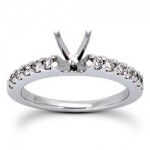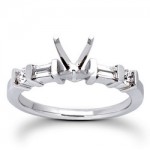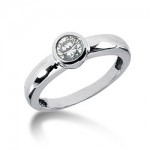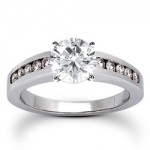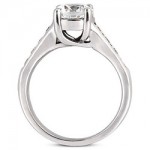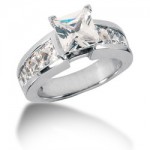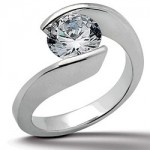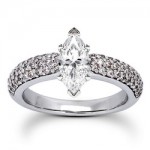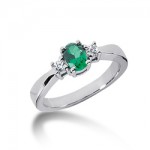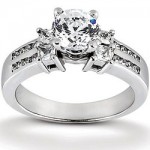The perfect engagement ring is more than just a diamond on a band – it’s a symbol of the love that you and your sweetie will share for the rest of your lives together. It’s a declaration to the world that you have finally found “The One” that you’re ready to share your world with. It’s also a wonderful way of showing off just how unique and special the relationship is between you and your future spouse!
Whether you’re looking for a unique engagement ring or inexpensive engagement rings, you’ll need to do a fair amount of research before you head to your nearest jeweler. After all, it’s not just the design of diamond itself that you’ll need to consider: you also need to investigate which engagement ring setting is just right for your sweetheart.
If you don’t know the difference between a prong setting and a tension setting – and every other setting in between – there’s no need to worry. Get ready to learn about the wonderful world of engagement ring settings!
What Is An Engagement Ring Setting?
Simply put, an engagement ring setting is the mounting which attaches the gemstone to the ring’s band. In this light, considering the right engagement ring setting isn’t just a question of style and taste – a great setting will also ensure that your sweetie’s precious gemstone doesn’t detached from the band.
Different engagement ring settings can lend an air of sophistication and elegance to a ring, or it can make a funky and unique statement; no matter what setting you choose, make sure that it reflects the tastes of your bride-to-be. The perfect engagement ring is something that she’s been dreaming about every since she was a little girl – and you want to make sure that you get it right when you finally go down on one knee!
Now that you know what an engagement ring setting is, let’s examine the different styles of settings that won’t just make an impact when you propose – they’ll commemorate the day that you and your love decided to share the rest of your lives together.
|
Prong Setting As one of the world’s most popular styles for engagement ring settings, the prong set engagement rings are featured in gorgeous and unique designs like the solitaire ring. Designed in 1886, the prong setting features what appears to be metal “claws” (otherwise known as the prong), which creates a basket shape where the gemstone sits. Four and six-prong styles are among the most popular choices for this particular setting, as it provides a firm yet symmetrical setting that allows for maximum light to shine through the diamond. Additionally, prongs can be flat, pointed or V-shaped; the shape you’ll choose depends on the cut of the gemstone. Ideally, heart and pear-shaped stones look best with V-shaped prongs, while emerald-cut stones stand out with flat prongs. While the prong setting style is ideal for larger diamonds, it’s not suited for smaller gemstones, as the prongs can appear to overwhelm delicate gemstones. |
| Bar Setting The bar setting functions like the prong setting, except the prongs are fused into thin metal bars which run vertically between the gemstones. This keeps the stones firmly in place while also showcasing the appearance of the ring’s metal. It’s a contemporary spin on a classic look; however, the unevenness of the design can cause discomfort to the wearer, especially if she’ll wear her ring every day. |
|
Bezel Setting A bezel setting on an engagement ring can not only keep your gemstone securely in place – the setting can also make smaller diamonds appear larger and intensify the look of colored gemstones! A metal band wraps around the perimeter of the circular gemstone, which protects the stone from receiving nicks or chips from everyday wear. If you’re decided on a bezel set engagement ring, then choosing the right type of metal can make a big impact on the brilliance of the stone. For example, a white metal surrounding a white or clear stone can make it appear much larger (perfect for those on a budget!), while a yellow metal setting can bring out the colors from a red or green gemstone. However, don’t choose a yellow metal for a white stone, as this will actually work to make the gemstone appear smaller. |
Channel Setting Channel settings have always been a popular choice for unique wedding bands, but now this style has been picked up by sleek and contemporary engagement rings. The channel setting – perfect for those engagement rings which have multiple stones – features a row of beautiful gemstones, which aren’t separated by any metals bands or prongs. This channel can extend on part or all around the ring, and is perfect for the woman who wants to wear her engagement ring on special occasions. While the channel setting provides more of a secure hold on gemstones and has a smooth surface, high-quality engagement rings featuring a channel setting can be extremely difficult to resize. Therefore, make sure you know your sweetie’s ring size before you venture into online diamond shopping! |
Trellis Setting The Trellis setting derives from a designer ring, and has been an extremely popular choice for engagement ring styles within the past decade. Trellis – which is the Latin word for “clear” – is a setting that features four sweeping metal claws and a very high crown. Because of this, the Trellis setting is perfect for princess-cut engagement rings, as it’s a simplistic yet luxurious design that highlights the brilliance and clarity of the stone. Perfect engagement rings featuring the Trellis setting are also much easier to clean; however, this setting is ideal for larger stones due to the high crown of the ring. |
Invisible Setting An engagement ring featuring an invisible setting is an extremely modern yet sleek choice for the bride-to-be that loves making a statement. The featured stone appears to be attached to the ring without any assistance from metal prongs or claws; hence, the origin of the “invisible” setting. However, don’t let your eyes deceive you: the stone actually rests inside a stable cup, which is then attached to the ring in a split design. The invisible setting is perfect for small-to-medium sized diamonds, as they’ll be much more secure within the cup than that of a larger diamond, as this can overwhelm the delicate illusion that this setting gives off. Unlike with tension rings, an engagement ring featuring an invisible setting can be easily resized and clean. |
Tension Setting As a newly popular choice for engagement rings, the tension setting gives the diamond the appearance of “floating” between the metal band. However, the gemstone isn’t floating at all; rather, it’s compressed between the metal band to keep it firmly in place. The tension setting is perfect for hard stones like diamonds, sapphires and rubies, as they’re the only gemstones which can withstand the large amount of pressure that’s required to keep the stone in place. Additionally, the tension setting allows plenty of light to hit the stone and maximize the brilliance. Smaller and larger diamonds can be used within the tension ring; however, the tension ring setting isn’t ideal for extremely small or large diamonds, as the size will then clash with the wedding band. If you’re thinking of getting a tension engagement ring for your sweetie, note that repair and maintenance is quite difficult due to the design of the setting, and can often only be done by the manufacturer. |
Pave Setting Pronounced “pah-vay”, the pave setting is a French-inspired design which features three or more rows of small stones fitted into holes that then place the gemstones at level with the surface of the ring’s band. The surrounding metal is raised to form tiny beads that are not only pleasing to the eye – they serve to keep the stones securely in place. The pave setting can give the illusion that the gemstones are much bigger than what they actually are, although the beads can provide a less secure setting than a prong or tension setting. Therefore, only smaller diamonds should be used with this type of engagement ring setting. Pave set rings are also more expensive than other engagement rings due to the number of stones needed; however, the impact that this gorgeous and elegant setting makes on the special day is more than worth it! |
Cluster Setting A cluster setting is perfect for the bride-to-be who wants a more personal touch to her perfect engagement ring. Featuring a cluster of multiple stones (typically made of semi-precious stones), this setting can accommodate personalized designs like a flower, heart or butterfly. The cluster setting can also be used to give off the appearance of a larger diamond, which is perfect for those future grooms on a wedding budget. Therefore, the cluster setting is appropriate for smaller gemstones, as they won’t serve to overwhelm the wedding band. While cluster settings can be difficult to clean due to the number of gemstones, this engagement ring style is a popular favorite for those brides who are looking for a more personal ring from their sweethearts. |
Varied Setting However, these engagement ring settings aren’t the only styles that you’ll find during your online diamond shopping – in fact, the only limit is your imagination! From engagement rings that feature two or more settings on a single band to a traditional prong setting flanked by smaller gemstones, don’t forget to expand your engagement ring search to include these beautifully varied settings. Additionally, varied settings can offer those on a budget with more affordable engagement ring choices, particularly if bought within a bridal set. |
What Should You Consider When Choosing The Setting?
To help you choose the perfect engagement ring for your sweetie, you’ll need to consider several factors that will help you to narrow down your choice.
First, budget plays an important role in deciding which engagement ring you can buy. Traditional prong, bar and bezel settings can provide an affordable engagement ring choice for couples on a budget – however, if you’re looking to buy a channel, Trellis or tension engagement ring, be prepared to fork over a little more of your wedding budget, as these rings tend to be more expensive.
Of course, budget isn’t the only factor you should consider when it comes to online diamond shopping; you’ll also need to think about the upkeep of the ring. Your sweetie will need to clean and tighten the settings on her ring in the future – are you prepared to pay a professional to do this, or would you prefer to do this yourself? For example, tension rings can only be maintained and resized by the manufacturer, while rings featuring an invisible setting are far simpler to clean and resize.
Most importantly, you’ll need to consider the taste of your bride-to-be. Is she a more traditional bride, or is she looking for a unique engagement ring? Does she want her ring to make a statement, or does she like a clean and elegant look? These aesthetic questions will ultimately help you to refine your search – as well as help you to choose the perfect engagement ring setting!
